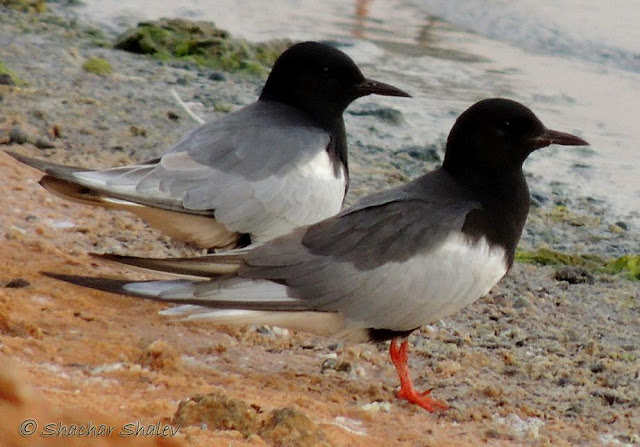This Spring is surely the one to be reminded as one of the least stable migration we had for years down in the Arava. While some morning start in full swing and there seems to be birds on every bush in the Arava and the sky are filled with migrating raptors, we have many mornings which seems to to be in an urgent need of a good kick-start!
Nevertheless we still enjoy a great variety of species that are coming through and like a ride on a roller-coaster some times we're up and sometime down...
At the beginning of this week we got a report through Jan, that one of our Lesser Whitethroats was controlled in Belgium! a short communication revealed that this bird has been trapped by our dreamteam 42 days earlier in Eilat and has covered the distance of at least 3577 Km during this period.
We also had an important visit by the Tourism Corporation Office staff of Eilat and they have enjoyed a great demonstration of the IBRCE ringing station with many species, great food from Tzadok and a good speech from Jan who has left us the next morning and we would like to thank him again.
But this is blog is about birds!
Over the last few days we've been re-trapping the nice 2CY Irania that was trapped also last week and every time it is a great addition of colours
Honey Buzzards have shown a huge influx and many thousands are passing daily over the mountains and the station. During this time of year we usually get many birds to treat and release just like this female which still retained one inner secondary of a juv' bird on both sides and thus is proposed to be a 3 CY bird.
A morning at the Gulf together with Avi Meir and Itsik Cohen produced no less than 11 Arctic, 3 Long-tailed and 1 Pomarine Skuas as well as 1 Sooty Shearwater, 4 Whimbrells many Little & Common Terns a single Black Tern, White-cheeked Tern few Gull-billed and Sandwich Terns and long staying Baltic Gulls.


Below is a another summery of the last period by Shachar (our Kiwi representative)...
"The Acacias of the Arava are bulging with fruit under the greenist caonopy seen here for many years. The ground ripples with insects and the air buzzes with dragonflies, flies and swarms of bird delicacies. The sea is overflowing with fish and the weather has been mild, beautiful.... in short a paradise for all birds. So where are they??? We stare down the gulf wondering if maybe they are waiting down there somewhere. Or maybe they have bypassed us? Some have even blamed that trapping in the Sinai Peninsula now that law and order has completely broken down there. But nothing deter our fearless ringers Jan and Markus as they coped with the onslaught of Blackcaps at the start of the week.
The Levant Spaarowhawks have also not disappointed with 2-3 diving into the nets each morning. And this is the catch, some days big waves of birds come through with some species reaching their normal spring levels while others are just missing. Where are the Red-backed Shrikes which were so abundant in spring? On the other hand the Masked Shrikes are coming through as usual. Where are the Cuckoos? Willow Warblers? Spotted Flycatchers?
When the ponds and bushes are empty I go down to the North Beach where the Terns are sure to please. I can watch their poise,grace and skill all day. One evening I was treated to a rare sight of thousands of Common Terns in a feeding frenzy. They abandoned their normal calm composed tactics for high speed clashes, stealing and squabbling over every catch. On that evening the Little Terns, Sandwich Terns and lone White-cheeked Tern kept their distance from the crazy mob.
At Km 20 the number of waders has dwindled with Little Stints, Wood Sandpipers,Collared Pratincoles and Greenshanks making up the bulk of the birds there. But with a careful look I found some Temmincks Stints, a group of 5 Broad-billed Sandpipers, the first Curlew Sandpipers and 3 White-winged terns.

Friday morning at the station, Itai arrived with a local group of fledgling birders, a big and very welcome step on the road to building a local community that will support the station and conservation of birds in this important but sadly neglected area. Despite a slow morning they were fortunate to see in the hand both male and female Levant Sparrowhawks, a rare Red-backed Shrike and the White-throated Robin that was first caught earlier in the week.
On Saturday morning Marcus noticed a Eurasian Nightjar lurking near the nets as he opened them. He smartly put the Nightjar call on the speaker and minutes later the bird was in the net, a first for this season...
Later, another first for the season arrived in the form of a female Golden Oriole much to everybody's pleasure. The strange morning ended with less than 60 birds, half of them retraps but 18 different species including 2 Garden Warblers, a late Whitethroat, Great Reed Warbler and a young Pied Flycatcher.
Can't wait to see what turns up tomorrow!"
On Saturday morning Marcus noticed a Eurasian Nightjar lurking near the nets as he opened them. He smartly put the Nightjar call on the speaker and minutes later the bird was in the net, a first for this season...
Later, another first for the season arrived in the form of a female Golden Oriole much to everybody's pleasure. The strange morning ended with less than 60 birds, half of them retraps but 18 different species including 2 Garden Warblers, a late Whitethroat, Great Reed Warbler and a young Pied Flycatcher.
Can't wait to see what turns up tomorrow!"

















































